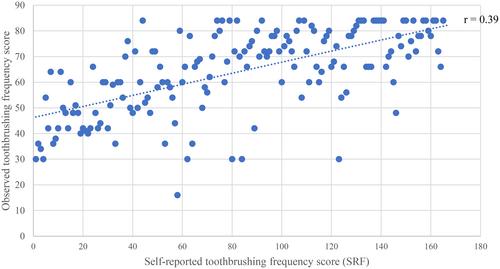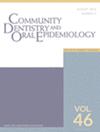Does the Self-Reported Behavioural Automaticity Index provide a valid measure of toothbrushing behaviour in adults?
Abstract
Background
Studies to promote regular toothbrushing usually rely on self-reports of toothbrushing frequency (SRF). However, toothbrushing frequency measures may be open to responder bias since twice-daily toothbrushing is a commonly accepted social norm. The validity of SRF measures is unclear, meaning that their use as outcomes in interventional work may be flawed. The study's aim was to compare two different self-reported toothbrushing measures: SRF and the Self-Reported Behavioural Automaticity Index (SRBAI); with measurement of observed toothbrushing frequency tracked over 6 weeks. A secondary aim was to explore the interaction effect of various moderators (age, ethnicity, socioeconomic status (SES), sex, self-efficacy, participant personality and routine preference) upon the correlation between SRBAI and observed toothbrushing frequency.
Methods
One hundred and sixty-four adults were recruited via a number of different community groups and workplaces outside the dental setting. After consent, participants completed a questionnaire which collected demographic and participant characteristics measures (age, ethnicity, SES, sex, self-efficacy, participant personality and routine preference) and self-reported toothbrushing habits. Participants then attached a ‘Brushlink’ device to their toothbrush for 6 weeks to track their observed toothbrushing frequency.
Results
Using the Pearson correlation coefficient, a moderately strong positive linear association (r = 0.65) between SRBAI and observed toothbrushing frequency was found. By comparison, the correlation between SRF and observed toothbrushing frequency was weak (r = 0.39). There was a weak positive association between self-reported behaviour frequency and SRBAI score (r = 0.35). Using multivariable linear regression, no statistically significant interactional effect was demonstrated for any moderator variable upon the correlation coefficient of SRBAI and observed toothbrushing frequency.
Conclusions
The SRBAI provided a stronger association with observed toothbrushing frequency than the SRF measure. A moderately strong relationship between SRBAI and observed toothbrushing frequency was found, compared to a weak positive relationship between self-reported behaviour frequency and SRBAI score. This suggests that the SRBAI score could be a suitable proxy to measure observed toothbrushing behaviour and preferable to SRF in interventional work.


 求助内容:
求助内容: 应助结果提醒方式:
应助结果提醒方式:


